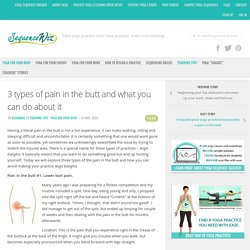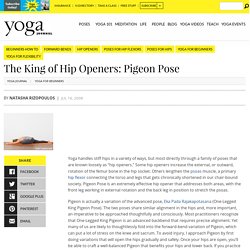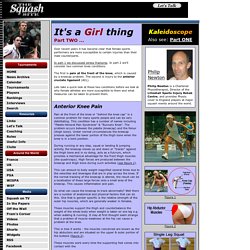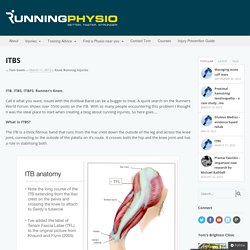

Google. Google. Test. Yoga practice to release piriformis tension. This home yoga practice will help you release tension in the piriformis muscles and other hip rotators.

This practice is not so much about “hip opening”, but more about the balance between the strength and flexibility in your hips. It may or may not be useful for the sciatic issues, depending on where the sciatic pain is coming from (read more about the potential sources of sciatic pain). If any pose seems to irritate your hips, don’t do it. Sequence Wiz is a web-based design tool that assists yoga teachers in creating and organizing yoga practices. Choose your poses, enter the instructions and you are done!
3 types of pain in the butt and what you can do about it. Having a literal pain in the butt is not a fun experience; it can make walking, sitting and sleeping difficult and uncomfortable.

It is certainly something that one would want gone as soon as possible, yet sometimes we unknowingly exacerbate the issue by trying to stretch the injured area. There is a special name for these types of practices – anga bangha. It basically means that you want to do something good but end up hurting yourself. Learn the King of Hip Openers: Pigeon Pose (Eka Pada Rajakapotasana) Yoga handles stiff hips in a variety of ways, but most directly through a family of poses that are known loosely as “hip openers.”

Some hip openers increase the external, or outward, rotation of the femur bone in the hip socket. Others lengthen the psoas muscle, a primary hip flexor connecting the torso and legs that gets chronically shortened in our chair-bound society. Pigeon Pose is an extremely effective hip opener that addresses both areas, with the front leg working in external rotation and the back leg in position to stretch the psoas. Neglecting your hip abductors can mess up your walk, sleep and balance. Few months ago this video of Jean Claude van Damme doing a split between two moving trucks made quite a stir and produced a number of copycats trying to do something similar.

Do not try this at home! Mr Van Damme continues to demonstrate a remarkable strength and flexibly in his inner and outer thigh muscles. Reverse clamshell exercise - S k p Google. Snyder Physical Therapy & Wellness. This will be the first in a series of monthly posts that I will be contributing to MedBridge Education, who is an online continuing education resource for physical and occupation therapists… According to Sipes et al, 30% of athletes suffer a shoulder injury during their career.

Of those injuries, subacromial impingement syndrome and rotator cuff tendonitis were the most common shoulder injuries for each individual sport and accounted for 27% and 24% of total shoulder injuries, respectively. More specifically, over-head throwing athletes are especially susceptible to shoulder pathology as 28% of all injuries in professional baseball have been shown to occur at the shoulder (Cante et al). Additionally, van der Windt et al conducted a prospective evaluation of over 300 patients. This analysis found that approximately 48% of shoulder injuries in a general population were diagnosed as subacromial impingement.
Supraspinatus: Infraspinatus: Teres Minor: Subscapularis: Additional Considerations: Iliopsoas Psoas höftböjare. Psoas är en muskel som har till huvuduppgift att hålla samman över- och underkropp.

Psoas består egentligen av tre muskler. Page4. Kaleidoscope. Pain at the front of the knee or ''behind the knee cap'' is a common problem for many sports people and can be very debilitating.

This condition has a number of names including ''Patello-femoral Pain Syndrome'' & "Runners Knee". The problem occurs between the patella (kneecap) and the femur (thigh bone). Under normal circumstances the kneecap presses against the lower portion of the thigh bone when the knee is in a bent position. During running or any step, squat or landing & jumping activity, the kneecap moves up and down or ''tracks'' against the thigh bone and in so doing, acts as a fulcrum, which provides a mechanical advantage for the front thigh muscles (the quadriceps).
High forces are produced between the kneecap and thigh bone during such activities (see figure 1). This can amount to body weight magnified several times due to the velocities and leverages that are in play across the knee. So what can cause the kneecap to track abnormally? Ground. Iliotibial Band Syndrome. ITB.

ITBS. ITBFS. Runner’s Knee. Call it what you want, issues with the Iliotibial Band can be a bugger to treat. Athletes Training Athletes. In this installment of our “injury of the week” series we’re going to be talking about piriformis strains.

We’re going to keep the same format we’ve had all along. First we’re going to start off with a review of what the injury is and talk about if this is what you have and when you need to worry/consult your doctor. From there we’re going to take you through the steps of the A-T-A self treatment system so that you’ll have a “sample treatment session”. Of all the areas I’m asked about, the hip is easily one of the most popular. It’s also one of the most complex in terms of it’s muscle/mobility and joint structures. 1) flexion and extension-forward and back.